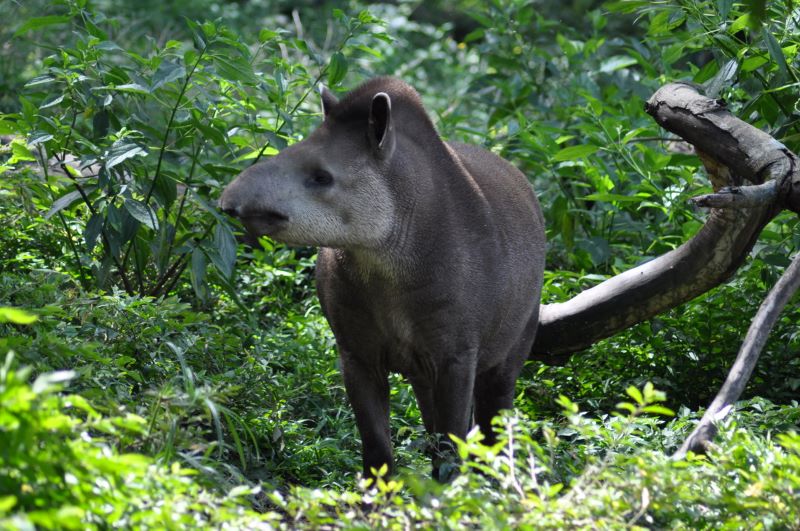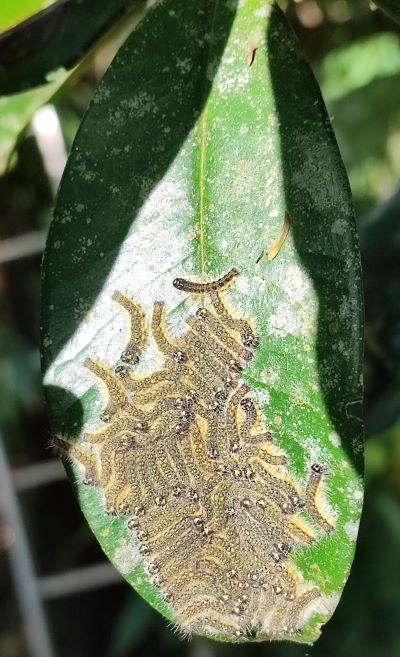

The Tapir (Tapirus terrestris) is the largest herbivore that inhabits tropical forests. Its extinction indirectly affects plant-pathogen interaction (photo: JP Krajewski)
Researchers in Brazil compared leaf damage caused by insects and pathogens in areas with and without the presence of mammals such as tapirs, deer and peccaries. Absence of the animals led to loss of microorganisms that cause leaf disease, potentially affecting long-term eco-evolutionary processes and reducing biodiversity in tropical forests.
Researchers in Brazil compared leaf damage caused by insects and pathogens in areas with and without the presence of mammals such as tapirs, deer and peccaries. Absence of the animals led to loss of microorganisms that cause leaf disease, potentially affecting long-term eco-evolutionary processes and reducing biodiversity in tropical forests.

The Tapir (Tapirus terrestris) is the largest herbivore that inhabits tropical forests. Its extinction indirectly affects plant-pathogen interaction (photo: JP Krajewski)
By André Julião | Agência FAPESP – Insects and microorganisms that feed on plants, cut up leaves, modify leaf tissue or produce leaf spots and other kinds of damage, are usually known as pests and considered harmful, yet interactions between plants and their natural enemies are important sources of biodiversity.
In tropical forests, for example, these “pests” are part of large ecological networks on which the functioning of ecosystems depends. If they decline, the entire forest may be affected, with consequences that are poorly understood.
An article published in the Journal of Ecology shows that the loss of large herbivorous mammals such as tapirs, deer and peccaries can be a factor in the decline of interactions between plants and their natural enemies.
“Plant species richness increases in the short term in the absence of large mammals that feed on plants and trample or change the structure of the soil. Because pathogens have very specific relationships with host plants, their capacity to spread and continue their life cycle decreases in areas with greater species richness. A decline in plant-pathogen interactions may have evolutionary consequences for both,” said Carine Emer, first and co-corresponding author of the article. The study it describes was conducted while she was a postdoctoral fellow at São Paulo State University’s Institute of Biosciences (IB-UNESP) in Rio Claro, Brazil, with a scholarship from FAPESP.

Atlantic Rainforest understory leaf damaged by natural enemies (photo: André Assis Bherig)
Another possible reason for falling pathogen abundance in the absence of large herbivores is the fact that these mammals travel long distances in the forest and carry microorganisms between plants, none of which happens when they become locally extinct.
The findings reported in the article resulted from two projects supported by FAPESP. The more recent one, “DEFAU-BIOTA: the effects of defaunation on soil carbon and plant functional diversity in the Atlantic Rainforest”, is funded via the FAPESP Research Program on Biodiversity, Characterization, Conservation, Restoration and Sustainable Use (BIOTA) and led by Mauro Galetti, a professor at IB-UNESP and last author of the article.
The other project was “Ecological consequences of defaunation in the Atlantic Rainforest”, also led by Galetti, who since 2009 has worked on a herbivore exclosure experiment comprising a large number of paired open-closed forest plots, each measuring 15 square meters, in four locations in São Paulo state. The closed plots are fenced to prevent the entry of large mammals. Animals can roam freely into and out of the open plots.
Camera traps on all plots enable the researchers to observe the effects of the exclusion of peccaries, tapirs, deer, pacas and agoutis (exclosure) on the plants and soil, as well as on ecological interactions such as leaf eating by insects. Previous research by the group demonstrated the importance of large mammals to soil fertilization, spatial structuring of plant communities and seed dispersal in forests (read more at: agencia.fapesp.br/34975/, agencia.fapesp.br/37789/ and agencia.fapesp.br/31840/).
Galetti is also one of the principal investigators for the Center for Research on Biodiversity and Climate Change (CBioClima), a Research, Innovation and Dissemination Center (RIDC) funded by FAPESP.
Mammals, insects and microorganisms
In their latest study, the researchers analyzed damage to 10,050 leaves from 3,350 plants in 86 plots in areas of Itamambuca, Ilha do Cardoso, Carlos Botelho State Park, and Vargem Grande Paulista. They classified leaf damage into five functional groups, including damage caused by insects (such as beetle larvae and butterflies) and by pathogens (such as bacteria, fungi and viruses). They analyzed leaves on plants with a height of 1 m or less. These trees and other plants belong to the understory, the layer of vegetation between the forest canopy and the forest floor, and are at the right level for large herbivores to be able to remove leaves.
The researchers rated leaf damage on a scale from 0 (no damage) to 6 (75%-99% damaged). In areas with no large herbivores (closed plots), total leaf damage was 9% lower (compared with open plots), and damage caused solely by pathogens was 29% lower. There were no significant differences in damage caused by insects on closed and open plots.
“Plants have interacted with their natural enemies for thousands of years in an arms race involving attack and defense. The defenses they’ve developed are both physical and chemical. Pathogens and other natural enemies create novel forms of attack, and plants respond with novel defenses. This process is key to producing and maintaining biodiversity since it can lead to the emergence of new species of plants and organisms that interact with them,” said Emer, currently a researcher at Rio de Janeiro Botanical Garden and Juruá Institute.
In the long run, a reduction in plant-pathogen interaction may mean that the process ceases to contribute to biodiversity via natural selection. Recently, for example, German researchers analyzed fossil leaves and showed how major changes to vegetation structures in the last 66 million years led to the loss of interactions and functional diversity in certain groups of herbivorous insects. A similar trend may have occurred as a result of pathogen loss in areas subject to changes in vegetation structures due to the loss of large mammals.
“Our study produced innovative results and for that very reason deserves to be extended to other areas of Atlantic Rainforest in Brazil, and to other tropical forests. In any event, it evidenced an additional problem that can be caused by the extinction of large mammals,” Emer said.
Nacho Villar, the other corresponding author of the article, received a postdoctoral scholarship from FAPESP at the time and is currently a researcher at the Netherlands Institute of Ecology (NIOO-KNAW).
Co-authors Natália Melo, Valesca Ziparro and Sergio Nazareth carried out the fieldwork and botanical identification.
The article “The interplay between defaunation and phylogenetic diversity affects leaf damage by natural enemies in tropical plants” is at: besjournals.onlinelibrary.wiley.com/doi/10.1111/1365-2745.14273.
Republish
The Agency FAPESP licenses news via Creative Commons (CC-BY-NC-ND) so that they can be republished free of charge and in a simple way by other digital or printed vehicles. Agência FAPESP must be credited as the source of the content being republished and the name of the reporter (if any) must be attributed. Using the HMTL button below allows compliance with these rules, detailed in Digital Republishing Policy FAPESP.





